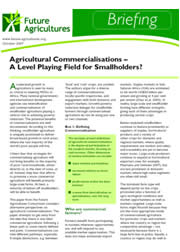{jathumbnail off} Accelerated growth in agriculture is seen by many as critical to meeting MDGs in Africa. Many national governments and international development agencies see intensification and commercialisation of smallholder agriculture playing a central role in achieving poverty reduction. The potential bene.ts of commercialisation are well documented.
Accelerated growth in agriculture is seen by many as critical to meeting MDGs in Africa. Many national governments and international development agencies see intensification and commercialisation of smallholder agriculture playing a central role in achieving poverty reduction. The potential bene.ts of commercialisation are well documented.
According to this thinking, smallholder agriculture is uniquely positioned to deliver broad-based growth in rural areas, where the vast majority of the world’s poor people still live. Others fear that strategies for commercialising agriculture will not bring bene.ts to the majority of poor rural households, either directly or, in the view of some, at all. Instead, they fear that efforts to promote a more commercial agriculture will benefit primarily large-scale farms. At best, a minority of better-off smallholders will be able to bene. This paper from the Future Agricultures Consortium considers alternative perspectives on agricultural commercialisation. The paper attempts to get away from the idea that there is one ideal commercial agriculture, following a linear path to some clearly de.ned end point.
Commercialisations can take different pathways, especially if simple distinctions, e.g. between ‘food’ and ‘cash’ crops, are avoided. The authors argue for a diverse range of commercialisations, locally speci.c trajectories, and engagement with both domestic and export markets. Growth-poverty reduction linkages for smallholder farmers through commercialized agriculture do not lie along just one or two channels.
